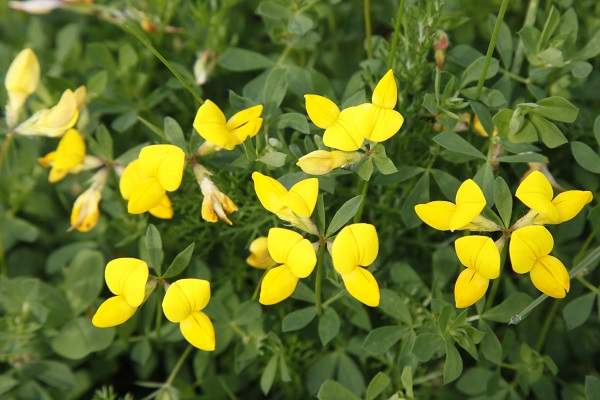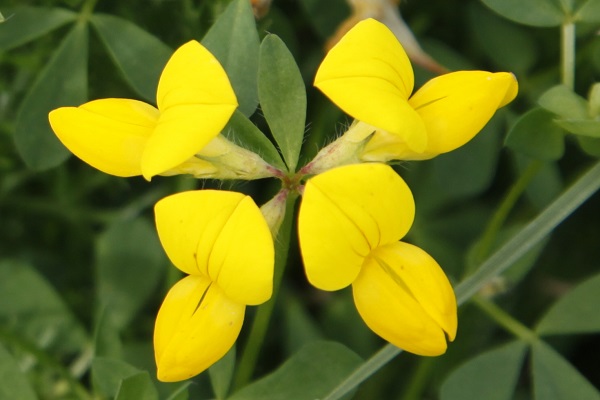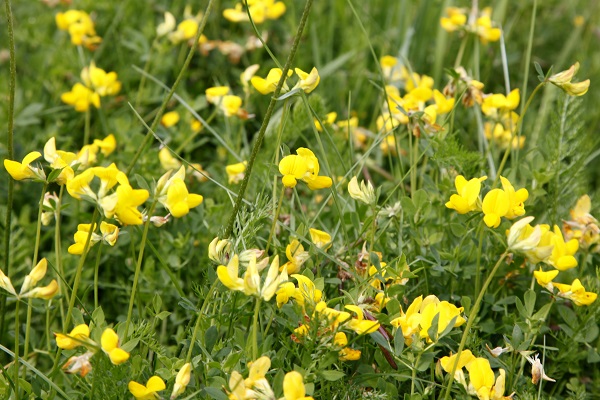Hebrew: לוטוס מקרין, Arabic: اللوطس الياباني
| Scientific name: | Lotus corniculatus L. | |
| Synonym name: | Lotus ambiguus Spreng., | |
| Common name: | Common Bird's-foot-trefoil | |
| Hebrew name: | לוטוס מקרין | |
| Arabic name: | اللوطس الياباني | |
| Family: | Fabaceae, Papilionaceae, Legume Family, משפחת הפרפרניים |

|
| Life form: | Herbaceous perennial, hemicryptophyte | |
| Spinescence: | Non-spinescent | |
| Succulence: | Non-succulent | |
| Stems: | Slender, numerous stems in close clusters, and branched | |
| Leaves: | Alternate, compound with 5 oval to linear leaflets, the central three held noticeable above the others, hence the use of the name trefoil | |
| Inflorescence: | An axillary, long-stalked, 2–6-flowered umbel | |
| Flowers: | Yellow, orange, red, sweet pea-like and develop in clusters of 2-8 on a stalk | |
| Fruits / pods: | Pods, cylindrical, separated by divisions between the seeds, and two-valved. | |
| Flowering Period: | April, May, June | |
| Habitat: | Humid | |
| Distribution: | Hermon | |
| Chorotype: | Euro-Siberian + Mediterranean + Irano-Turanian | |
| Summer shedding: | Ephemeral |

Derivation of the botanical name: Lotus from Greek lôtos and originally applied to a fruit which was said to make those who tasted it forget their homes. corniculata, corniculum, "little horn; helmet ornament" - horned. Bird's-foot-trefoil refers to the slender seedpods which resemble the foot of a bird.
(from the book "British Wild Flowers - In Their Natural Haunts Vol2-4", by A. R. Horwood) In Lotus corniculatus we have a type of the relation of parts to insect visits typical of flowers like the Pea in general. There are five petals, of which the upper is erect and called the standard. Below these are the two wings or alae. The other two lower petals are united along the anterior margin to form a carina or keel. The nine stamens of the Bird's Foot are united at the base to form a tube encircling the pistil, and project beyond it into a triangular cavity at the bottom of the keel which is a repository for pollen. The tenth is free. The alae are locked by projecting knobs fitting into a hollow opposite. An insect alighting on the flower bears down the alae and the keel, which is pushed over the column or ring of stamens and forces the pollen up into the cavity and against the abdomen of the insect, and when the insect goes off to another flower the parts return again to their former position and cover up the pollen. The bee is able to reach the honey when the tenth stamen is free. In other species of Leguminosae where the tenth stamen is united there is usually no honey. Pollen is discharged when the anthers burst before the flowers are opened. Of the two groups of five stamens one has thickened ends, and after the five inner anthers have shrivelled they fill the hollow in the keel in which the pollen is collected. The wings and keel are both depressed when a bee alights, and being locked together they spring back as by a piston mechanism after pressure is removed. Lotus corniculatus attracts Hymenoptera (Apidae), Diptera, Sphinges, Sesia, Zygaena, Bombyces, Porthesia, Noctuae, Euclidia, etc. It is the primary foodplant for Callophrys rubi (Green Hairstreak), Erynnis tages (Dingy Skipper), Everes argiades (Short-tailed Blue), Leptidea juvernica (Cryptic Wood White), Leptidea sinapis (Wood White), and Plebeius argus (Silver-studded Blue),Polyommatus icarus (Common Blue). 
*Pictures taken in Ragunda, Sweden (see: www.flowersinsweden.com/Lotuscorniculatus_page.htm). |